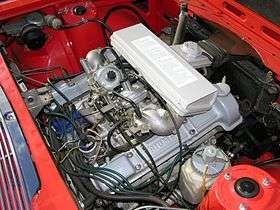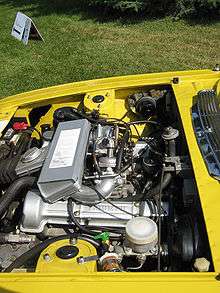Triumph V8
| Triumph V8 | |
|---|---|
 | |
| Overview | |
| Manufacturer | Triumph Motor Company |
| Production | 1971 - 1977 |
| Combustion chamber | |
| Displacement | 2997 cc |
| Cylinder bore | 86 mm (3.386 in) |
| Piston stroke | 64.5 mm (2.539 in) |
| Cylinder block alloy | cast iron |
| Cylinder head alloy | aluminium |
| Valvetrain | single overhead cam per bank |
| Compression ratio | 8.8:1 |
| Combustion | |
| Fuel type | petrol |
| Cooling system | water |
| Output | |
| Power output | 145 bhp (108 kW) @5500 rpm |
| Torque output | 170 lb·ft (230 N·m) @3500 rpm |

The Triumph V8 is a 3.0 litre V8 developed in house by Triumph for the Triumph Stag. This was basically two Triumph Slant-4 engines . It consisted of a single overhead cam per bank, cast iron block with aluminium heads.
Development
The Stag was developed between 1964 and 1969. Whilst originally seen as little more than a convertible version of the Triumph 2000 saloon, as development progressed the Stag gained its own identity until the final design shared no body panels or pressings with the 2000. The Stag was intended to use Triumph's existing 2.5-litre straight-6 engine. When the Stag design evolved into a grand tourer rather than a more conventional sports car it became clear that a more powerful, more refined engine was needed.
As far back as 1963 the designer of the Triumph Slant-4 engine, Lewis Dawtrey, had foreseen the possibility that the engine design could be 'doubled-up' to create a V8 unit. Whilst at this point the engine had only been produced in 1.7-litre form by Triumph for sale to Saab, the basic design of the engine enabled capacities as low as 1.2-litres to be built. Triumph revived the V8 concept, initially settling on a 2.5-litre engine (in essence two 1.2-litre versions of the slant-4) with mechanical fuel injection provided by Bosch.
Following the take-over of Triumph by Leyland Motors in 1967 Spen King was placed in charge of product development at Triumph. The V8's Bosch fuel injection was running into numerous difficulties in development and King was unable to convince Leyland to divert extra funds to Triumph to solve the problems. Instead, King dropped the fuel injection in favour of twin Zenith-Stromberg carburetors. To maintain the required power output the capacity was increased to 3-litres, which then entailed modification to the Stag's other drivetrain systems included the gearbox, back axle and brakes. This relatively 'last-minute' capacity increase was achieved by expanding the bore of the engine instead of the stroke, which explains the Triumph V8's unusual 'oversquare' internal dimensions. This widening of the bore also meant that the water galleries surrounding the cylinders were narrower than originally planned, thus creating one of the engine's major weaknesses (see below).
Design
As launched in 1970 the Triumph V8 had several innovative features. As well as its unusual construction (the crankcase and cylinder block were made from chromium iron whilst the cylinder heads were aluminium alloy), the engine featured a unique arrangement of studs and bolts attaching the cylinderheads that allowed the cylinderheads to be removed (in design, not in reality) without firstly removing the overhead camshafts and disturbing the valveplay adjustment. The water pump, oil pump and distributor were all driven at their required speeds from a single jackshaft driven from the timing chain via sets of skew-cut gears. The cooling fan was a 16-blade plastic item driven through a hydraulic viscous coupling that limited fan speed to 2,500 rpm to reduce noise as well as controlling the fan speed in relation to engine temperature.
Issues
This engine can suffer from unreliability as a result of the following design problems:
- Overly long single link chains with poor automatic tensioning that only last about 25,000 miles (40,200 km). The damage is extensive if they fail;
- Inadequately sized main bearings - these have short lives as a result;
- The aluminium heads warp due to poor castings which restrict coolant flow, leading to overheating;
- Water pump failures relating to the drive gear shearing.
- Water pump was located above the reservoir tank and the radiator. As a result, when coolant leaks occurred, the coolant was not able to be circulated at all due to the high mounting of the water pump.
- Due to the different metal alloys used in the cylinder block and head, specific coolant was required to prevent internal electrolysis and corrosion of the cooling system. This fact was not widely known, even at a dealership level; resulting in the incorrect coolant being used in engines, exacerbating the already existing cooling system problems.
- Due to the cylinder head design (Removal of the heads was designed to be accomplished whilst leaving the camshaft and valvetrain in place), head bolts were both vertically and diagonally set in the engine block, to be accessible around the camshafts. As the bolts were made of the same material and set on different angles; this created areas of different expansion under heat, creating not only head warping but resulting in extremely difficult to remove cylinder heads as bolts stretched and corroded in place at different rates.
- As a legacy of the V8's beginnings as a straight-4 design the sender unit for the temperature gauge is located in one cylinder head (rather than a point of the cooling system common to both heads as on other multi-bank engines). This means that problems can go undetected in one head until enough damage and/or overheating has occurred to affect the one fitted with the sender unit.
Many modern day upgrades and sticking to the manufacturer's recommended service schedules help to solve these problems. An air dam for a TR-6 helps solve a cooling problem by scooping up the air in front of the car. A 12 blade fan helps to pull more air though the radiator.
Potential other uses
Triumph originally intended their V8 to be used across their range, which was the reason for the company's willingness to fund the engine's high development costs. Plans were made to create a 'Triumph 3000' by fitting the engine into the 2000 saloon, but these plans were halted when Rover joined Triumph in the Leyland grouping as the resulting car would have been a direct competitor for the Rover 'P6' 3500. Triumph also tried to sell the engine to the Morgan Motor Company but that company chose the Rover V8 as well. Saab tested the V8 in the Saab 99 mainly for US markets but the oil crisis in 1973 finally caused cancellation of the project in favour of turbocharging. The result was the V8 remained unique to the Stag.
See also
References
- Observer's Book of Automobiles P. Olyslager. 1972 Frederick Warne, London. ISBN 0-7232-1508-1
- Taylor, J, 1983 "Triumph Stag - Super Profile", Haynes Publishing, UK. ISBN 0-85429-342-6
- Lindh, B-E, 1987 "Saab The first 40 years", Förlagshuset Norden AB, Sweden. ISBN 91-86442-34-1